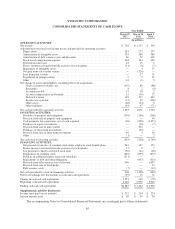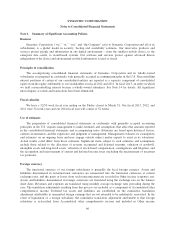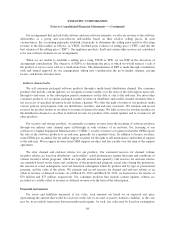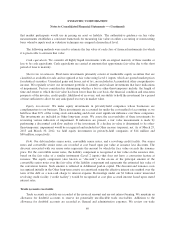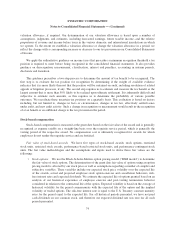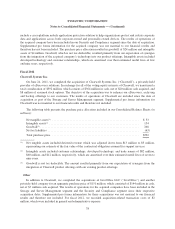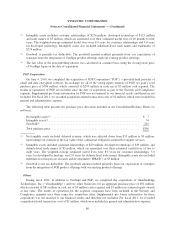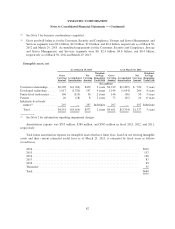Symantec 2013 Annual Report Download - page 172
Download and view the complete annual report
Please find page 172 of the 2013 Symantec annual report below. You can navigate through the pages in the report by either clicking on the pages listed below, or by using the keyword search tool below to find specific information within the annual report.SYMANTEC CORPORATION
Notes to Consolidated Financial Statements — (Continued)
valuation allowance, if required. Our determination of our valuation allowance is based upon a number of
assumptions, judgments, and estimates, including forecasted earnings, future taxable income, and the relative
proportions of revenue and income before taxes in the various domestic and international jurisdictions in which
we operate. To the extent we establish a valuation allowance or change the valuation allowance in a period, we
reflect the change with a corresponding increase or decrease to our tax provision in our Consolidated Statements
of Income.
We apply the authoritative guidance on income taxes that prescribes a minimum recognition threshold a tax
position is required to meet before being recognized in the consolidated financial statements. It also provides
guidance on derecognition, measurement, classification, interest and penalties, accounting in interim periods,
disclosure and transition.
This guidance prescribes a two-step process to determine the amount of tax benefit to be recognized. The
first step is to evaluate the tax position for recognition by determining if the weight of available evidence
indicates that it is more likely than not that the position will be sustained on audit, including resolution of related
appeals or litigation processes, if any. The second step requires us to estimate and measure the tax benefit as the
largest amount that is more than 50% likely to be realized upon ultimate settlement. It is inherently difficult and
subjective to estimate such amounts, as this requires us to determine the probability of various possible
outcomes. We reevaluate these uncertain tax positions on a quarterly basis. This evaluation is based on factors
including, but not limited to, changes in facts or circumstances, changes in tax law, effectively settled issues
under audit, and new audit activity. Such a change in recognition or measurement would result in the recognition
of a tax benefit or an additional charge to the tax provision in the period.
Stock-based compensation
Stock-based compensation is measured at the grant date based on the fair value of the award and is generally
recognized as expense ratably on a straight-line basis over the requisite service period, which is generally the
vesting period of the respective award. No compensation cost is ultimately recognized for awards for which
employees do not render the requisite service and are forfeited.
Fair value of stock-based awards. We have five types of stock-based awards: stock options, restricted
stock units, restricted stock awards, performance-based restricted stock units, and performance-contingent stock
units. The fair value methodologies and the assumptions and inputs used to derive those fair values are the
following:
•Stock options. We use the Black-Scholes-Merton option pricing model (“BSM model”) to determine
the fair value of stock options. The determination of the grant date fair value of options using an option
pricing model is affected by our stock price as well as assumptions regarding a number of complex and
subjective variables. These variables include our expected stock price volatility over the expected life
of the awards, actual and projected employee stock option exercise and cancellation behaviors, risk-
free interest rates and expected dividends. We estimate the expected life of options granted based on an
analysis of our historical experience of employee exercise and post-vesting termination behavior
considered in relation to the contractual life of the option. Expected volatility is based on the average of
historical volatility for the period commensurate with the expected life of the option and the implied
volatility of traded options. The risk-free interest rate is equal to the U.S. Treasury constant maturity
rates for the period equal to the expected life. For all historical periods presented, we have not paid
cash dividends on our common stock, and therefore our expected dividend rate was zero for all such
periods presented.
74



